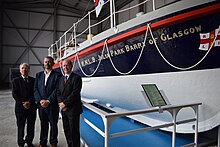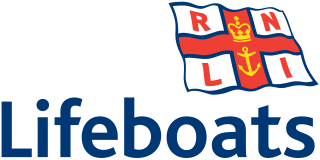
The Royal National Lifeboat Institution (RNLI) is the largest of the lifeboat services operating around the coasts of the United Kingdom, Ireland, the Channel Islands, and the Isle of Man, as well as on some inland waterways.

The Penlee lifeboat disaster occurred on 19 December 1981 off the coast of Cornwall, England. The Royal National Lifeboat Institution (RNLI) lifeboat Solomon Browne, based at the Penlee Lifeboat Station near Mousehole, went to the aid of the vessel Union Star after its engines failed in heavy seas. After the lifeboat had rescued four people, both vessels were lost with all hands. Sixteen people died, including eight volunteer lifeboatmen.
Since its inception, the Royal National Lifeboat Institution (RNLI) has provided lifeboats to lifeboat stations in the United Kingdom and Ireland.

RNLB Louisa Heartwell was the sixth lifeboat to be stationed at Cromer on the coast of the English county of Norfolk She was launched from the beach station and was on station from 1902 to 1932. During her period on station at Cromer the Louisa Heartwell had only two coxswains during her 29-year career. They were Matthew James Buttons Harrison until his retirement in 1909, and then Henry George Blogg.

Wells-next-the-Sea Lifeboat Station is located at the end of Beach Road, about 1 mi (1.6 km) north of the town of Wells-next-the-Sea, on the north coast of the English county of Norfolk.
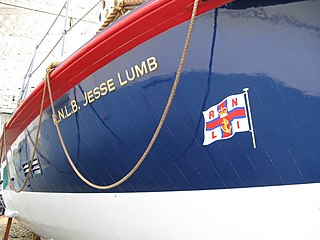
RNLB Jesse Lumb is a historic lifeboat. Built by J. Samuel White in 1939, Jesse Lumb served as the lifeboat at Bembridge on the Isle of Wight from 1939 to 1970, becoming the last of her type in service. Since 2000 she has been preserved at Classic Boat Museum, Cowes. In August 1999 she was inscribed on the National Register of Historic Vessels, becoming part of the National Historic Fleet.

RNLB Foresters Centenary is a retired Liverpool-class lifeboat of the Royal National Lifeboat Institution (RNLI), stationed in the English coastal town of Sheringham in the county of Norfolk in the United Kingdom. The lifeboat was on station for 25 years between 1936 and 1961 when she was sold. She has been restored to her original condition and is exhibited in Sheringham Museum.

RNLB Duncan was the first RNLI lifeboat placed on station in the English coastal town of Sheringham in the county of Norfolk, United Kingdom. The arrival of this lifeboat also coincided with the construction of the first RNLI lifeboat station. The station and boat worked in conjunction with the already established private Fishermans lifeboat station also in the town.

RNLB Helen Smitton is a Watson-class lifeboat built by Thames Ironworks and Shipbuilding Company in 1910. Helen Smitton served as the lifeboat at St Abbs, Berwickshire, Scotland from 1911 to 1936 and was the village's first lifeboat.

RNLB Lucy Lavers was an RNLI lifeboat which was on No. 2 station at Aldeburgh from 1940 until 1959 when she was placed in the reserve fleet until 1968 when she was retired. The Rescue Wooden Boats Charity is currently undertaking restoration of the vessel. The Lucy Lavers is entered in the National Historic Ships register and has the Certificate No 2206.

RNLB Abdy Beauclerk was a 41ft 'Aldeburgh' Type Beach Motor which was stationed in the town of Aldeburgh in the English county of Suffolk. She was on the No: 1 station at Aldeburgh from 1931 until she was sold out of the RNLI fleet in 1959, a total of 28 years service.

RNLB Emma Constance was a Barnett-class lifeboat stationed at Aberdeen Lifeboat Station, in the Scottish city of Aberdeen from 1927 until August 1951. The lifeboat was designed by James R. Barnett who was a consulting naval architect to the Royal National Lifeboat Institution (RNLI).

Hunstanton Lifeboat Station is located in the village of Old Hunstanton, in the English county of Norfolk. It is the only lifeboat station on the east coast of England which faces westward, being positioned on the east side of the square-mouthed bay and estuary known as The Wash.

Selsey Lifeboat Station is a Royal National Lifeboat Institution (RNLI) station located in Selsey, West Sussex on the south coast of England.
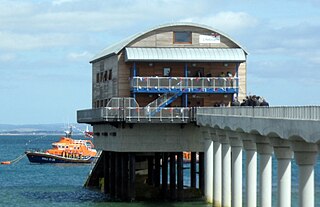
Bembridge Lifeboat Station is located in the village of Bembridge on the Isle of Wight in the United Kingdom. The station is located on the eastern approaches to The Solent, south of the area known as Spithead. The station is on one of the busiest shipping lanes in United Kingdom waters. The main boathouse stands away from the shore on a piled platform with slipway, and is linked to the shore by a pier gangway.
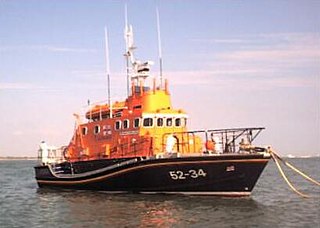
RNLB Margaret Russell Fraser was an Arun-class lifeboat which served in the Royal National Lifeboat Institution(RNLI) Relief Fleet for 16 years before being placed on station at the Calshot Lifeboat Station in Calshot, Hampshire, United Kingdom.
Sir Lewis Duthie Ritchie is a Scottish medical doctor who worked as a general practitioner (GP) and medical researcher. He is the James Mackenzie Professor of General Practice at the University of Aberdeen and holds honorary professorships at the University of Edinburgh and the University of the Highlands and Islands.
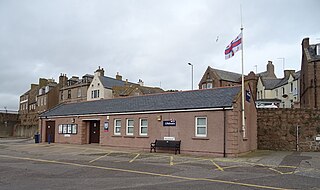
Peterhead Lifeboat Station is located at West Pier, in the harbour town of Peterhead, in the NE corner of Aberdeenshire, Scotland.

Irvine Lifeboat Station was located next to Irvine Beach breakwater, at the mouth of the River Irvine, in Irvine, a harbour town and former royal burgh overlooking the Firth of Clyde and the Isle of Arran, in the county of North Ayrshire, historically Ayrshire, on the south-west coast of Scotland.
